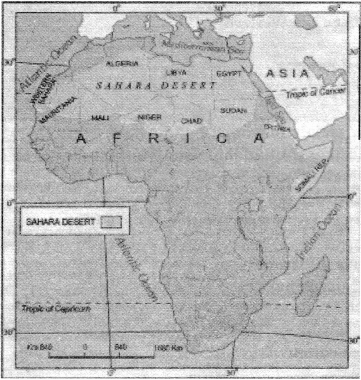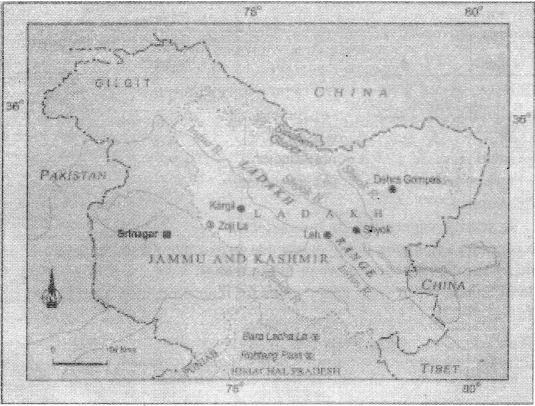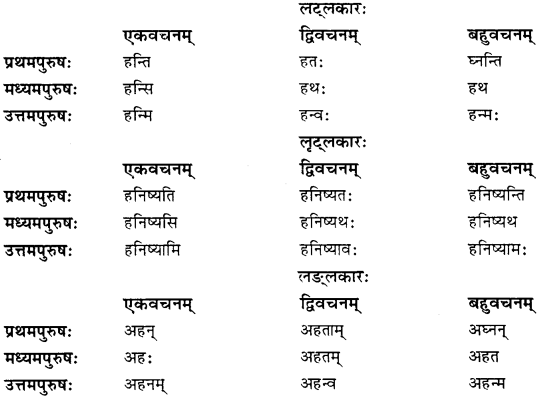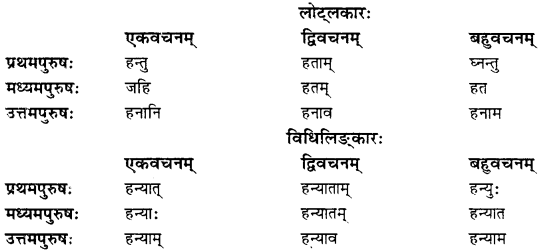Shemushi Sanskrit Class 10 Solutions Chapter 7 सौहार्दं प्रकृतेः शोभा
अभ्यासः
प्रश्ना 1.
अधोलिखितप्रश्नानामुत्तराणि एकपदेन लिखत
(क) वनराजः कैः दुरवस्थां प्राप्तः?
उत्तर:
वानरेः
(ख) कः वातावरणं कर्कशध्वनिना आकुलीकरोति?
उत्तर:
काकः
(ग) काकचेष्टः विद्यार्थी कीदृशः छात्रः मन्यते?
उत्तर:
आदर्श
(घ) कः आत्मानं बलशाली, विशालकायः, पराक्रमी च कथयति।
उत्तर:
गजः
(ङ) बकः कीदृशान् मीनान् क्रूरतया भक्षयति?
उत्तर:
वराकान्
(च) मयूरः कथं नृत्यमुद्रायां स्थितः भवति?
उत्तर:
पिच्छानुद्घाट्य
(छ) अन्ते सर्वे मिलित्वा कस्य राज्याभिषेकाय तत्पराः भवति?
उत्तर:
उल्लूकस्य
(ज) अस्मिन्नाटके कति पात्राणि सन्ति?
उत्तर:
दश
प्रश्ना 2.
अधोलिखितप्रश्नानामुत्तराणि पूर्णवाक्येन लिखत-
(क) नि:संशयं कः कृतान्तः मन्यते?
उत्तर:
निःसंशयं जन्तुवः कृतान्तः मन्यते।
(ख) बकः वन्यजन्तूनां रक्षोपायान् कथं चिन्तयितुं कथयति?
उत्तर:
बकः वन्यजन्तूनां रक्षोपायान् चिन्तयितुं कथयति यत् सः ध्यानमग्नः स्थितप्रज्ञ इव स्थित्वा सर्वेषाम् रक्षायाः करिष्यति।
(ग) अन्ते प्रकृतिमाता प्रविश्य सर्वप्रथम किं वदति?
उत्तर:
प्रकृतिमाता प्रविश्य सर्वप्रथमं कथयति “भोः भोः प्राणिनः यूयम सर्वे एव में सन्ततिः। कथं मिथः कलहं कुर्वन्ति।
(घ) यदि राजा सम्यक् न भवति तदा प्रजा कथं विप्लवे?
उत्तर:
यदि राजा सम्यक् न भवति तदा प्रजा नौकाइव विप्लवेत्।
प्रश्ना 3.
रेखांकितपदमाधृत्य प्रश्ननिर्माणं कुरुत
(क) सिंहः वानराभ्यां स्वरक्षायाम् असमर्थः एवासीत्।
उत्तर:
सिंहः वानराभ्यां किमर्थ असमर्थः एवासी?
(ख) गजः वन्यपशून् तुदन्तं शुण्डेन पोथयित्वा मारयति।
उत्तर:
गजः वन्यपशून् तुदन्तं केन् पोथयित्वा मारयति?
(ग) वानरः आत्मानं वनराजपदाय योग्यः मन्यते।
उत्तर:
वानरः आत्मानं कस्मै योग्यः मन्यते?
(घ) मयूरस्य नृत्यं प्रकृतेः आराधना।
उत्तर:
मयूरस्य नृत्यं कया आराधना?
(ङ) सर्वे प्रकृतिमातरं प्रणमन्ति।
उत्तर:
सर्वे किम् प्रणमन्ति?
प्रश्ना 4.
शुद्धकथनानां समक्षम् आम् अशुद्धकथनानां च समक्षं न इति लिखत-
(क) सिंहः आत्मानं तुदन्तं वानरं मारयति।
उत्तर:
न
(ख) का-का इति बकस्य ध्वनिः भवति।
उत्तर:
न
(ग) काकपिकयोः वर्णः कृष्णः भवति।
उत्तर:
आम
(घ) गजः लघुकायः, निर्बलः च भवति।
उत्तर:
न
(ङ) मयूरः बकस्य कारणात् पक्षिकुलम् अवमानितं मन्यते।
उत्तर:
न
(च) अन्योन्यसहयोगेन प्राणिनाम् लाभः जायते।
उत्तर:
आम्
प्रश्ना 5.
मञ्जूषातः समुचितं पदं चित्वा रिक्तस्थानानि पूरयत-
स्थितप्रज्ञः, यथासमयम्, मेध्यामध्यभक्षकः, अहिभुक्, आत्मश्लाघाहीनः, पिकः।
(क) काकः…………………भवति।
उत्तर:
मेध्यामध्यभक्षकः
(ख) ………………..परभृत् अपि कथ्यते।
उत्तर:
पिकः
(ग) बकः अविचलः………………..इव तिष्ठति।
उत्तर:
स्थितप्रज्ञः
(घ) मयूरः………………….इति नाम्नाऽपि ज्ञायते।
उत्तर:
अहिभुक्
(ङ) उलूकः…………………पदनिर्लिप्तः चासीत्।
उत्तर:
आत्मश्लाघीहीनः
(च) सर्वेषामेव महत्त्वं विद्यते………………….।
उत्तर:
यथासमयम।
प्रश्ना 6.
परिचयं पठित्वा पात्रस्य नाम लिखत-
(क) अहं शुण्डेन कमपि पोथयित्वा मारयितुं समर्थः।
उत्तर:
गजः
(ख) मम सत्यप्रियता सर्वेषां कृते उदाहरणस्वरूपा।
उत्तर:
काकः
(ग) मम पिच्छानामपूर्व सौन्दर्यम्।
उत्तर:
मयूरः
(घ) अहं पराक्रमिणं भयंकरं वापि जन्तुं पराजेतुं समर्थः।
उत्तर:
वानरः
(ङ) अहं वनराजः। कथं सर्वे मिलित्वा मां तुदन्ति?
उत्तर:
सिंहः
(च) अहम् अगाधजलसञ्चारी अपि गर्व न करोमि?
उत्तर:
प्रकृतिमाता
(छ) अहं सर्वेषां प्राणिनां जननी अस्मि।
उत्तर:
प्रकृतिमाता
(ज) एषः तु करालवक्त्रः दिवान्धः चास्ति।
उत्तर:
काकः
प्रश्ना 7.
वाच्यपरिवर्तनं कृत्वा लिखत
उदाहरणम्- क्रुद्धः सिंहः इतस्ततः धावति गर्जति च।
– क्रुद्धेन सिंहेन इतस्ततः धाव्यते गय॑ते च।
(क) त्वया सत्यं कथितम्।
उत्तर:
त्वं सत्यं कथितम्।
(ख) सिंहः सर्वजन्तून् पृच्छति।
उत्तर:
सिहेन् सर्वजन्तून् पृच्छ।
(ग) काकः पिकस्य संततिं पालयति।
उत्तर:
काकेन् पिकस्य सन्ततिं पालयते।
(घ) मयूरः विधात्रा एव पक्षिराजः वनराजः वा कृतः।
उत्तर:
विधाता मयूरं एव पक्षिराजः वनराजः वा अकरोत।
(ङ) सर्वैः खगैः कोऽपि खगः एव वनराजः कर्तुमिष्यते स्म।
उत्तर:
सर्वाः खगाः कोऽपि खगः एव वनराजः कर्तुम् इच्छाति स्म।
(च) सर्वे मिलित्वा प्रकृतिसौन्दर्याय प्रयत्नं कुर्वन्तु।
उत्तर:
सर्वे मिलित्वा प्रकृति सौन्दर्याय प्रयत्नं कुर्वेयुः।
प्रश्ना 8.
समासविग्रहं समस्तपदं वा लिखत
(क) तुच्छजीवैः …………………………।
उत्तर:
तुच्छजीवैः तुच्छैः जीवैः।
(ख) वृक्षोपरि ………………………………।
उत्तर:
वृक्षोपरि वृक्षस्य उपरि।
(ग) पक्षिणां सम्राट् ………………………………..।
उत्तर:
पक्षिणां सम्राट् पक्षिसम्राट।
(घ) स्थिता प्रज्ञा यस्य सः …………………………।
उत्तर:
स्थिता प्रज्ञा यस्य सः स्थित प्रज्ञः।
(ङ) अपूर्वम् …………………………।
उत्तर:
अपूर्वम् न पूर्वः।
(च) व्याघ्रचित्रका …………………………।
उत्तर:
व्याघ्रचित्रका व्याघ्र च चित्रकाश्च।
प्रश्ना 9.
प्रकृतिप्रत्ययविभागं कुरुत/योजयित्वा वा पदं रचयत
(क) क्रुध्+क्त ………………………………….।
उत्तर:
क्रुध्+क्त कुद्धः।
(ख) आकृष्य ………………………………….।
उत्तर:
आकृष्य आ + कृष् + ल्यप्।
(ग) सत्यप्रियता ………………………………….।
उत्तर:
सत्यप्रियता सत्यप्रिय + तल।
(घ) पराक्रमी …………………………….।
उत्तर:
पराक्रमी पराक्रम + ङीप।
(ङ) कूक्त्वा …………………………….।
उत्तर:
कू+क्त्वा कर्दयित्वा।
(च) शृण्वन् …………………………….।
उत्तर:
शृण्वन् शृणु + शतु।
योग्यताविस्तारः
विचित्रे खलु संसारे नास्ति किञ्चित् निरर्थकम्।
अश्वश्चेत् धावने वीरः, भारस्य वहने खरः॥
महान्तं प्राप्य सद्बुद्धे! संत्यजेन्न लघु जनम्।
यत्रास्ति सूचिकाकार्य कृपाणः किं करिष्यति॥
‘शाण्डिल्यशतकम्’ से उद्धृत ये दोनों श्लोक भी इसी बात की पुष्टि करते हैं कि संसार में कोई भी छोटा या बड़ा नहीं है, सभी का अपना-अपना महत्त्व है जैसे- घोड़ा यदि दौड़ने में निपुण है तो गधा भारवहन में, सुई जोड़ने का कार्य करती है तो कृपाण काटने का अतः संसार की क्रियाशीलता और गतिशीलता में सभी का अपना-अपना महत्त्व है। सभी के अपने-अपने कार्य हैं, अपना-अपना योगदान है अतः हमें न तो किसी कार्य को छोटा या बड़ा, तुच्छ या महान् समझना चाहिए और न ही किसी प्राणी को। आपस में मिलजुल कर सौहार्द-पूर्ण तरीके से जीवन यापन करने में ही प्रकृति का सौन्दर्य है। विभिन्न प्राणियों से सम्बन्धित निम्नलिखित श्लोकों को भी पढ़िए और रसास्वादन कीजिए-
इन्द्रियाणि च संयम्य बकवत् पण्डितो नरः।
देशकालबलं ज्ञात्वा सर्वकार्याणि साधयेत्॥
काकचेष्टः बकध्यानी श्वाननिद्रः तथैव च।
अल्पाहारः गृहत्यागः विद्यार्थी पञ्चलक्षणम्॥
स्पृशन्नपि गजो हन्ति जिघ्रन्नपि भुजङ्गमः।
हसन्नपि नृपो हन्ति, मानयन्नपि दुर्जनः।
प्राप्तव्यमर्थ लभते मनुष्यो, देवोऽपि तं लङ्घयितुं न शक्तः ।
तस्मान्न शोचामि न विस्मयो मे यदस्मदीयं न हि तत्परेषाम्॥
अयं निजः परो वेति गणना लघुचेतसाम्।
उदारचरितानां तु वसुधैव कुटुम्बकम्॥
वस्तुतः मित्रों के बिना कोई भी जीना पसन्द नहीं करता चाहे उसके पास बाकी सभी अच्छी चीजें क्यों न हों अतः हमें सभी के साथ मिलजुल कर, अपने आस-पास के वातावरण को तथा प्रकृति की सुरक्षा और सुन्दरता में सदैव सहयोग करना चाहिए वस्तुतः तभी हमारी ये कामनाएँ भी सार्थक हो सकती हैं-
सर्वे भवन्तु सुखिनः, सर्वे सन्तु निरामयाः।
सर्वे भद्राणि पश्यन्तु, मा कश्चित् दुःखभाग्भवेत्।।
तथा च
अधुना रमणीया हि सृष्टिरेषा जगत्पतेः।
जीवाः सर्वेऽत्र मोदन्तां भावयन्तः परस्परम्॥
These Solutions are part of NCERT Solutions for Class 10 Sanskrit. Here we have given NCERT Solutions for Class 10 Sanskrit Shemushi Chapter 7 सौहार्दं प्रकृतेः शोभा.



